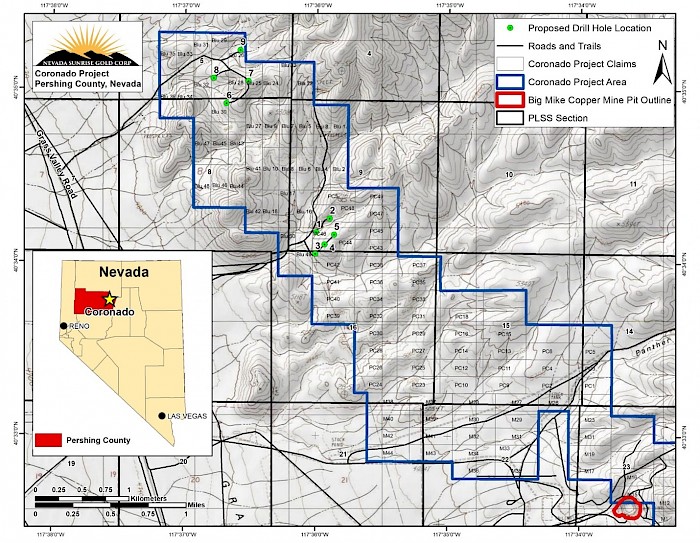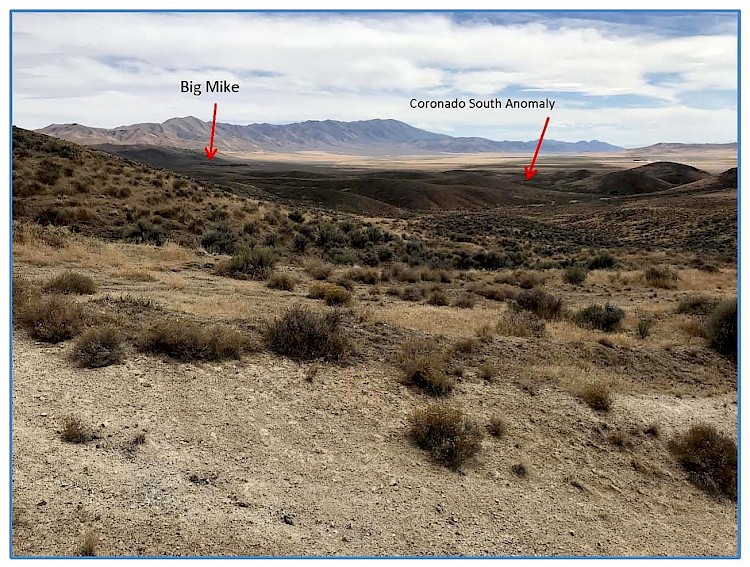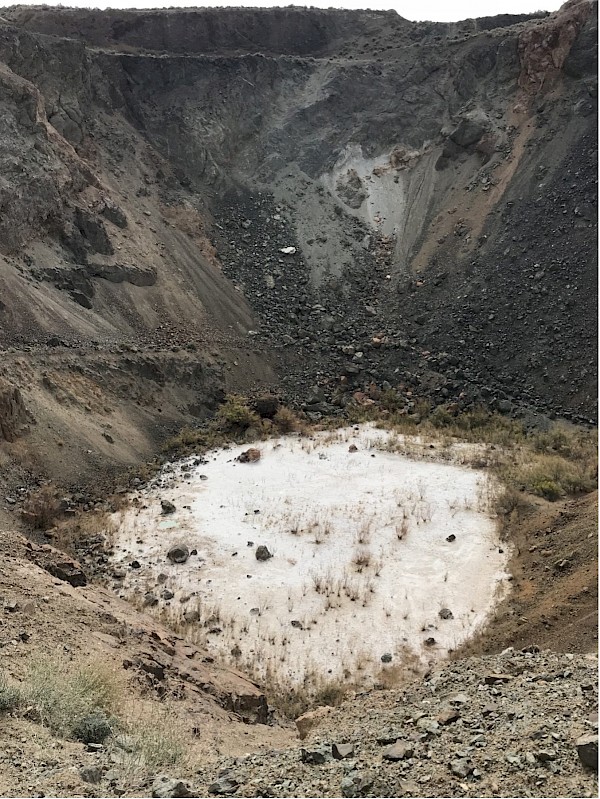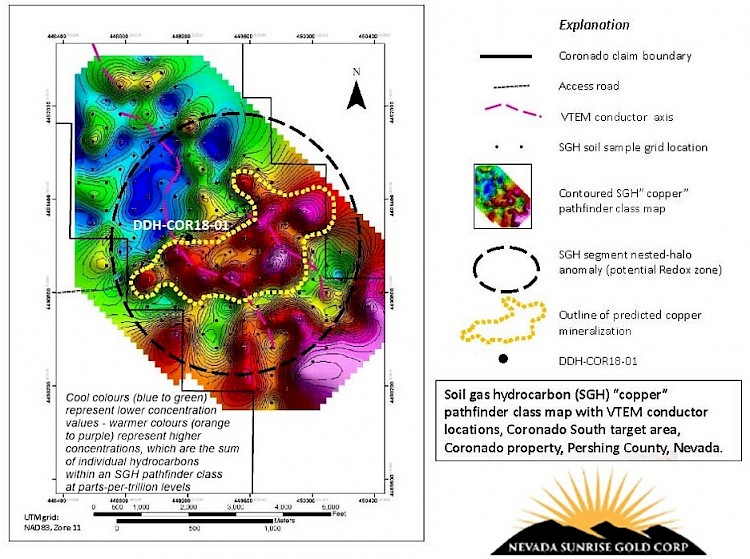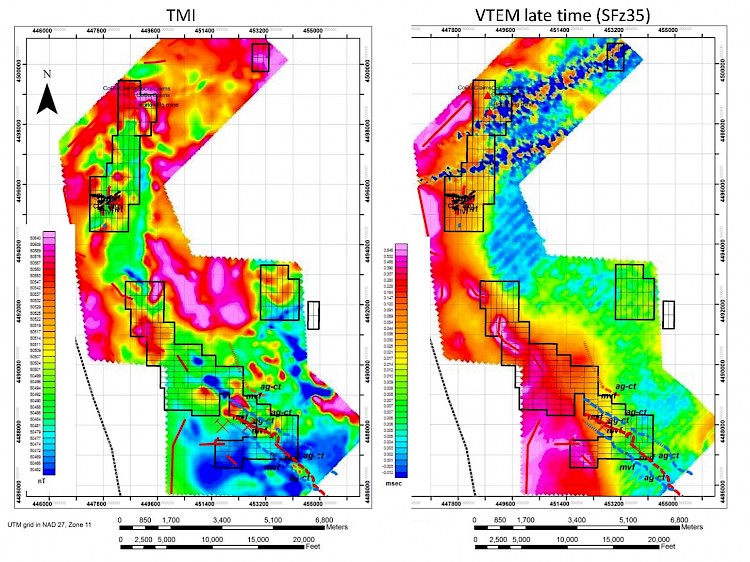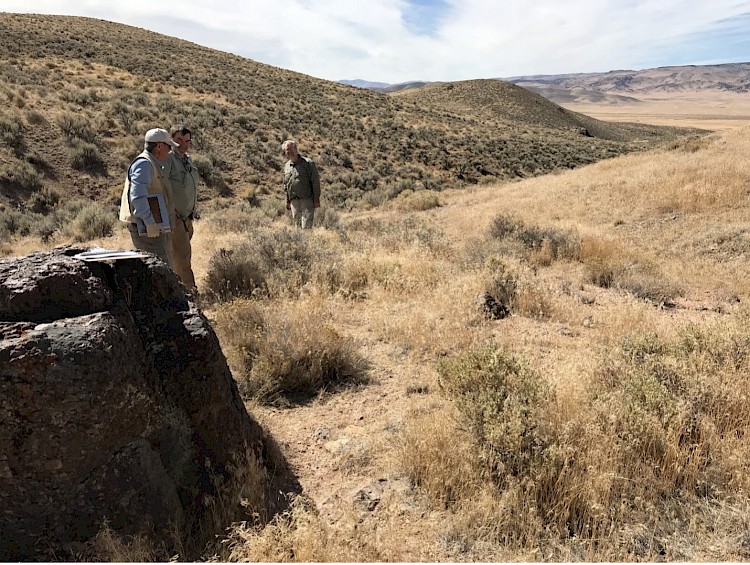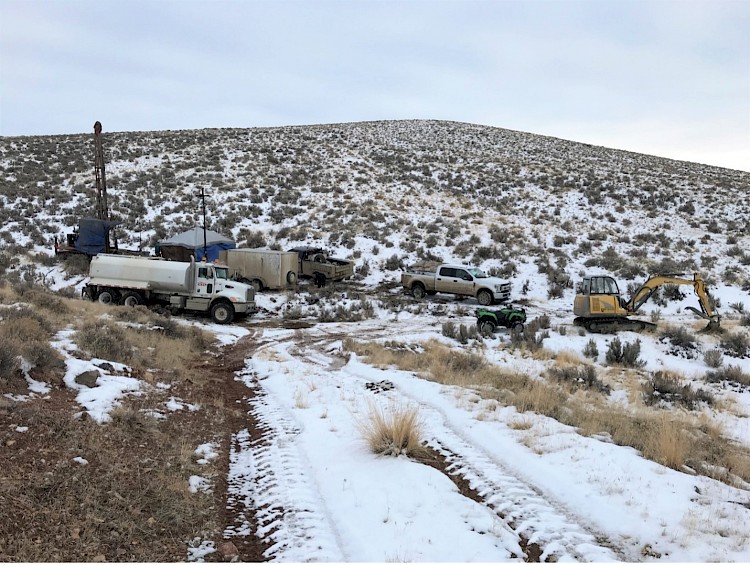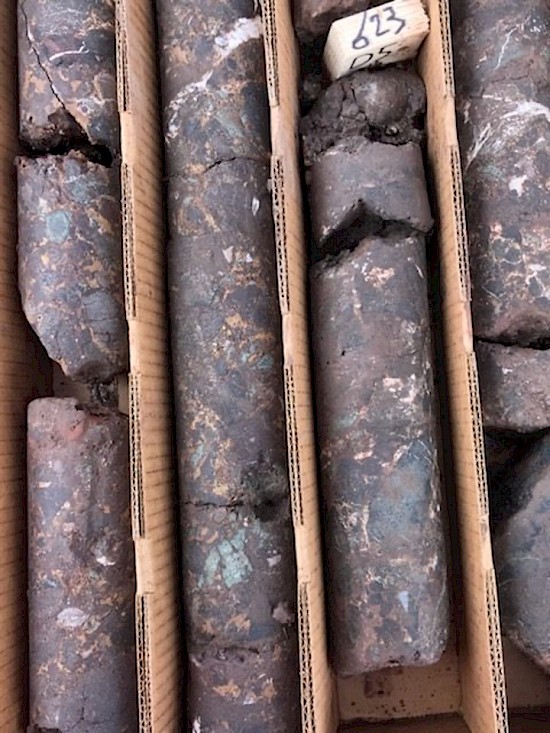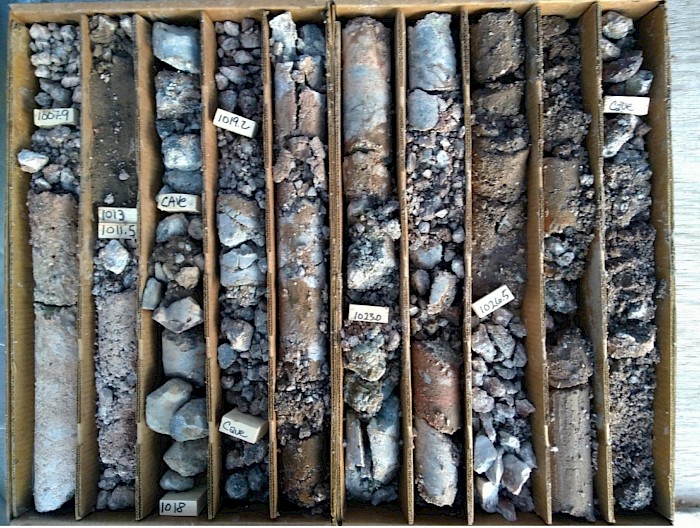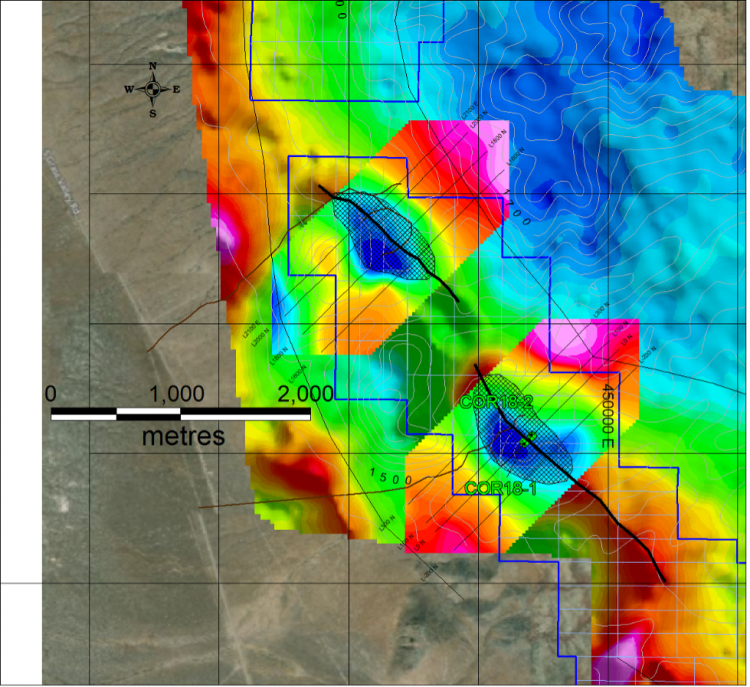The Coronado Copper Project (“Coronado”) is located in the Tobin and Sonoma Range of Pershing County, Nevada, approximately 48 kilometers (30 miles) southeast of Winnemucca.
Coronado Copper Project Claims Map
Coronado currently consists of 152 unpatented claims totaling approximately 3,040 acres (1,230 hectares) located over an interpreted trend adjacent to the historic Big Mike open pit copper mine (“Big Mike”) that lies within the Middle Pennsylvanian to Late Permian-age Havallah volcanic-sedimentary sequence. Big Mike was discovered in the 1960s, mined out in the 1970s and is today classified as a volcanogenic massive sulphide (“VMS”) deposit, terminology which was not readily applied to volcanogenic mineral deposits until widely-adopted in the 1980s. Nevada Sunrise believes that other Copper deposits may be present along trend from Big Mike, as such deposits are known to occur in a series, or clusters.
Coronado South project area and proximity to Big Mike mine
In 1969, Cerro Corp. published a historical resource estimate for Big Mike of 634,000 tons grading 3.41% copper, which included 74,000 tons of massive sulphide ore grading 11.78% copper, and 380,000 tons of oxide and mixed ore grading 3.16% copper1.
1 This historical estimate, which is dated February 21, 1969, uses categories that are not consistent with National Instrument 43-101 (“NI 43-101”) and cannot be readily compared to NI 43-101 categories. A qualified person has not done sufficient work to classify the estimate as a current resource and Nevada Sunrise is not treating the estimate as a current resource estimate. A portion of the ground on which this estimate was based was subsequently mined. However, the estimate is relevant to guiding the Company’s exploration plans and provides geological information regarding the type of mineralization that could be present in the Coronado area.
In 1970, Ranchers Exploration and Development Company (“Ranchers”) developed the high-grade portion of the deposit with an open pit mine at Big Mike that produced approximately 25 million pounds of copper in 100,000 tons of ore grading 10.5% copper, which was shipped directly to smelters in West Germany and Japan. Heap leaching of lower-grade disseminated copper ore was also carried out by Ranchers; approximately 300,000 tons of mineralized rock was treated. Historical sampling also shows the presence of cobalt at Big Mike, with values in the deposit ranging up to 2,500 parts per million (0.25%) cobalt (Rye et al, Economic Geology, Vol. 79, 1984). Big Mike was mined out in 1970.
Interior of Big Mike Open Pit, 2018
Coronado Copper Project- Big Mike VMS Deposit Study (DeMatties, 2024)
2020 Drilling Program
On December 15, 2020, Nevada Sunrise announced the conclusion of the 2020 Coronado drilling program, which began in the first week of November 2020.
Two diamond drill holes were collared at locations identified by the previous airborne Versatile Time Domain Electromagnetic (“VTEMEM”) geophysical survey as optimal for penetration of the interpreted conductor. A total of 250.76 metres (822.7 feet) was drilled in the two diamond core holes. Each of the drill holes encountered difficulty penetrating through the overburden and viscous clay layers, and the bedrock targets were not intersected.
DDH-COR20-01 was drilled to 151.37 metres (496.6 feet), at which depth ground conditions made further advance impossible. The drill hole encountered a fault zone composed of clay gouge and breccia at 136.89 metres (449.1 feet). Drilling continued through this zone for 14.48 metres (47.5 feet) until the hole was abandoned. This fault zone intersection may represent an extension of the thrust fault encountered in the Company’s previously drilled hole DDH-COR18-01. Formations identified in the core indicate that surface colluvium and the upper part of the Havallah greenstone sequence are situated above the fault as in DDH-COR18-01.
DDH-COR20-02 was drilled through the surface colluvium to a depth of 99.39 metres (326.1 feet), at which depth further advance was impeded by a viscous clay layer. This viscous clay is either a layer within the surface colluvium or it may be associated with a fault gouge zone at this depth.
Nevada Sunrise intends to test the Coronado South conductor in a future drilling program with a combination of RC drilling and diamond drilling to penetrate the problematic layers of overburden and continue into bedrock to best intersect the strong VTEMEM airborne conductor detected by the Company in 2018.
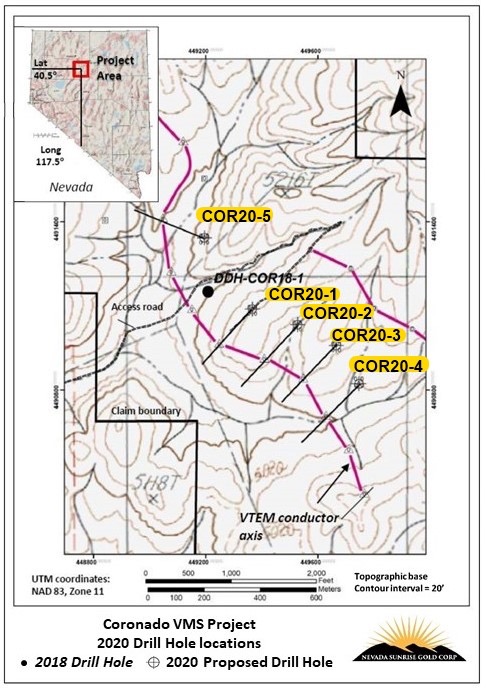
2020 Geochemical Sampling Program
On October 8, 2020, Nevada Sunrise announced the results of a geochemical sampling program at Coronado. The survey detected a cluster of strong geochemical anomalies above the Coronado South geophysical conductor.
Highlights of the 2020 Coronado Geochemical Survey
In August 2020, 162 soil samples were collected from a grid established across the surface trace of the Coronado South conductor, which is an airborne electromagnetic anomaly defined by the Company’s helicopter-borne 2018 geophysical survey. The soil samples were submitted to Activation Laboratories Ltd. in Ancaster, Ontario (“Actlabs”) for Spatiotemporal Geochemical Hydrocarbons (“SGH”) analysis.
The 2020 SGH results showed a classic “segment nested halo” geochemical anomaly. Nevada Sunrise commissioned an additional analytical study from Actlabs to focus on the specific SGH hydrocarbon signatures predicted to be associated with copper mineralization and the result is shown in the picture below:
1 3D – SGH, “A Spatiotemporal Geochemical Hydrocarbon Interpretation” for Nevada Sunrise Gold Corporation, Coronado South SGH Project, Activation Laboratories Ltd., September 21, 2020
This initial soil survey program represents the Company’s first test of the SGH process, a nano-geochemistry method developed by Actlabs, which has been reported to detect buried sulphide mineralization at depths up to 500 metres. The results from the 2020 SGH survey give confidence to the Company’s interpretation of the geological setting at Coronado, and have been integrated into the target matrix for future diamond drilling programs.
Soil samples described above were analyzed by the SGH method developed by Actlabs. Upon receipt, samples are air-dried and then sieved with the -80 mesh sieve fraction collected. From the collected pulp, compounds are separated by gas chromatography and detected by mass spectrometry at a reporting limit of one part per trillion.
Exploration by Nevada Sunrise, 2018-2019
In July 2018, Nevada Sunrise announced the results of an airborne electromagnetic (“EM”) survey totaling 648 line kilometres carried out on Coronado. Preliminary interpretation of the VTEM™ (Versatile Time Domain Electromagnetic) survey, a leading-edge airborne survey method developed by Geotech Ltd. of Aurora, Ontario, Canada, outlined the presence of several significant conductive anomalies located near Big Mike that display the geophysical hallmarks Copper deposits.
2018 VTEM Survey Results
Follow-up ground geological investigations carried out by Nevada Sunrise at Coronado in early September 2018 within the areas of the best VTEM conductive anomalies confirmed the presence of sulphides on surface and other geological features consistent with the surface expression of a buried Copper deposit. At the Coronado South anomaly, outcrops exposing a section of thin bedded to laminated chert exhalite and cherty tuffaceous sediments were mapped and sampled.
Coronado site visit, September 2018
The chert exhalite beds contained fine-grained oxidized (Fe-stained) sulfide casts and locally relict anhedral pyrite grains (up to 1%). The presence of sulphides in the chert beds immediately adjacent to the Coronado South anomaly suggests it is spatially related to the electromagnetic conductor. Of particular importance is that this exhalite section is comparable to those found within the Big Mike mine sequence and the historic open pit located approximately 2.9 miles (4.5 kilometres) to the southeast. The presence of a number of VTEM anomalies along trend suggests district-scale potential and a typical clustering of the Copper deposits.
2018 Drilling Program
On January 10, 2019, Nevada Sunrise announced the results of the first diamond drill hole at Coronado. Sulphides were encountered in the hole above and below a wide fault zone, but geochemical values of metals such as copper, gold, nickel, cobalt and zinc were low, and not of economic interest. However, Nevada Sunrise believes that as a first test of the Coronado South geophysical anomaly, drill hole COR18-01 represents a “near-miss” of the best part of the target, and that further drilling is warranted at Coronado.
COR18-01 drill hole setup
Summary of COR18-01
Hole COR18-01 was completed at the Coronado South target to a depth of 375.73 metres (1,232 feet). Winter drilling conditions necessitated an alternate location for the initial drill hole and a site approximately 170 metres (550 feet) from the original location was chosen to test an EM anomaly detected in the 2018 airborne survey. The drill hole intersected what is believed to be the stratigraphic upper portion of the host volcanic section for the EM anomaly, which demonstrated a complex structural regime.
Downhole conditions were difficult during the program and daily drilling progress was slower than anticipated. An altered volcanic section that included argillites, basalt flows and flow breccias was intersected below 164.6 to 194.5 metres (540 feet to 638 feet) before being faulted off. This section is interpreted to be the stratigraphic hanging wall to the EM conductor. Significant hydrothermal epidote-chlorite alteration was evident in the flows and flow breccias below 188 metres (618 feet). After intersecting the volcanic section and fault zone, the hole encountered a different structural block dominated by bedded cherts. The fault structure is believed to have disrupted the stratigraphic lower portion of the host volcanic sequence and position of the conductor by displacing it to the east.
Epidote alteration in COR8-01 at 190 metres (623 feet)
The Company’s geologists observed that the drill hole passed through at least three major fault zones. Several weakly-developed stockwork sulphide zones were encountered deeper in the hole at depth intervals from 268.2 to 274.4 metres (881 to 900 feet) and 313.1 to 316.46 metres (1027 to 1038 feet). These zones consisted of fracture-controlled, cross-cutting, and fresh to strongly oxidized pyrite veinlets and disseminations (< 1%).
Example of fault zone encountered in drill hole COR18-01
2019 Coronado Gravity Survey
On May 2, 2019, Nevada Sunrise announced the results of a ground gravity survey at Coronado.
The ground gravity survey was carried out over the most conductive part of the Coronado South target, with survey lines centered over a strong airborne EM anomaly detected in 2018. Eighty-four gravity readings were taken at 100 metre station intervals on four lines extending 1,000 metres on either side of the interpreted conductor axis to delineate the gravity profile. An additional 84 gravity readings were also taken over the Coronado North target located approximately 1,750 metres to the north.
The 2019 gravity survey outlined zones of low gravity coincident with the Coronado North and South EM anomalies, which was an unexpected result for such highly-conductive zones with higher magnetic susceptibility. Based on specific gravity (i.e., density) measurements from samples taken within the property area, Nevada Sunrise believes that the measured gravity lows could represent the weathered caps (gossans and/or leached cappings) of flat-lying or gently dipping, Copper mineralization.
Residual gravity over VTEM conductive anomalies at Coronado South
This interpretation is supported by field observations at the nearby Big Mike mine. Here, deep weathering and oxidation (at least 200+ feet) resulted in severe leaching of a near-surface, moderately dipping VMS lens and underlying stringer zone. As a consequence, a well-developed, siliceous and auriferous boxwork gossan zone and leached capping developed. Continued weathering activity culminated in supergene-copper-enrichment of a deeper lens.
Nevada Sunrise believes the density contrast between the upper gossan-leached capping and mafic (basaltic) volcanic host Havallah sequence could generate a gravity low similar to those detected by the survey. Further, the deeper copper-enriched massive sulfide lens at Big Mike, which was eventually mined out, would have produced a very strong EM anomaly located below the gravity low feature. A remarkably similar geophysical scenario has been identified at the Coronado anomalies. Nevertheless, an associated gravity high anomaly would be expected with the deeper supergene-enriched lens. However, such an anomaly could be too deep to detect or masked by the gravity low feature or a combination of both these conditions.
This weathering event may be in part recent, but it is more likely related to a protracted, late Permian paleoweathering episode that affected the entire Havallah sequence. Paleoweathering ended upon deposition of stratigraphically overlying Triassic volcanic formations. It would be reasonable to expect that any VMS deposit exposed along the paleoweathering surface which developed over the Havallah sequence to exhibit such geophysical characteristics.
Nevada Sunrise plans to continue testing of the strong EM conductors at Coronado North and South in a future drilling program, in conjunction with downhole EM surveys designed to gather geophysical information at depth.
Theodore DeMatties, CPG, PG, is the Company’s designated Qualified Person for this document within the meaning of NI 43-101 and has reviewed and approved the technical information contained herein. Readers are cautioned that some of the technical information described in this news release is historical in nature; however, the information is deemed credible and was produced by professional geologists of the eras discussed. Mineralization located on adjacent properties by historical exploration may not be present on Coronado.
Details of Coronado Option Agreement Terms
On September 25, 2018, the Company entered into a definitive option agreement to acquire a 100% interest in the Coronado property in consideration for cash and share payments and a schedule of exploration expenditures.
In January 2022, the Company entered into an amended agreement for the Coronado property with the cash and shares payments and exploration expenditures required as follows:
|
Payment Due Dates |
Cash Payments |
Share Payments |
Minimum Exploration Expenditures |
|---|---|---|---|
|
On or before September 25, 2021 |
US$50,000 (paid subsequent to December 31, 2021) |
500,000 |
US$300,000 |
|
On or before September 25, 2022 |
US$50,000 |
500,000 |
US$300,000 |
|
On or before September 25, 2023 |
US$50,000 |
500,000 |
US$300,000 |
|
On or before September 25, 2024 |
US$50,000 |
500,000 |
US$300,000 |
|
On or before September 25, 2025 |
US$50,000 |
500,000 |
US$300,000 |
|
On or before September 25, 2026 |
US$1,050,000 |
600,000 |
US $NIL |
The vendor shall retain a 2% net smelter returns royalty, half of which can be purchased by the Company at any time for US$1,500,000, minus any advance royalty payments made by the Company. An advance royalty payment of US$500,000 would be payable to the vendors upon completion of a feasibility study.


